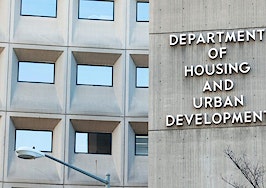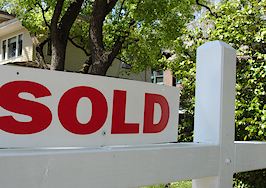We’ll add more market news briefs throughout the day. Check back to read the latest.
Most recent market news:
Wednesday, April 5
Attom Data Solutions: 2016 property tax analysis
- States with the highest effective property tax rates were New Jersey (2.31 percent), Illinois (2.13 percent); Texas (2.06 percent); New Hampshire (2.03 percent); and Vermont (2.02 percent).
- States with the lowest effective property tax rates were Hawaii (0.32 percent); Alabama (0.48 percent); Colorado (0.52 percent); Tennessee (0.54 percent); and Delaware (0.56 percent).
- Among 586 counties with a population of at least 100,000 and at least 10,000 single family homes, nine posted average annual property taxes of more than $10,000: Westchester, Rockland, and Nassau counties in New York; Essex, Bergen, Union and Morris counties in New Jersey; Marin County, California; and Fairfield County, Connecticut.
- Owner-occupied properties register higher effective tax rate than investment properties
- The average annual property tax for owner-occupied single family homes nationwide was $3,658, an effective tax rate of 1.21 percent. That was higher than the average annual property tax of $2,437 and effective tax rate of 1.03 percent on non-owner occupied (investment) homes.
Home equity rates:
[graphiq id=”kPkTJrAnX5r” title=”Average Home Equity Loan Bank Rates by State” width=”600″ height=”465″ url=”https://w.graphiq.com/w/kPkTJrAnX5r” link=”http://mortgage-lenders.credio.com” link_text=”Average Home Equity Loan Bank Rates by State | Credio”]
[graphiq id=”kPkTJrAnX5r” title=”Average Home Equity Loan Bank Rates by State” width=”600″ height=”465″ url=”https://w.graphiq.com/w/kPkTJrAnX5r” link=”http://mortgage-lenders.credio.com” link_text=”Average Home Equity Loan Bank Rates by State | Credio”]
[graphiq id=”dP0v3iYOnH” title=”Average Home Equity Loan Credit Union Rates by State” width=”600″ height=”465″ url=”https://w.graphiq.com/w/dP0v3iYOnH” link=”http://mortgage-lenders.credio.com” link_text=”Average Home Equity Loan Credit Union Rates by State | Credio”]
Mortgage rates:
[graphiq id=”b2w6fmfIyNL” title=”30-Year Fixed Rate Mortgage Rates for the Past 6 Months” width=”600″ height=”400″ url=”https://w.graphiq.com/w/b2w6fmfIyNL” link=”http://mortgage-lenders.credio.com” link_text=”30-Year Fixed Rate Mortgage Rates for the Past 6 Months | Credio”]
News from earlier this week
Tuesday, April 4
CoreLogic U.S. Home Price Report
- National Forecast Indicates Home Prices Expected To Increase 4.7 Percent by February 2018
- Home Prices Expected to Rise by 0.4 Percent Between February 2017 and March 2017
- Home Prices Increased by 1 Percent between January and February 2017
“Home prices and rents have risen the most in local markets with high demand and limited supply, such as Seattle, Portland and Denver,” said Dr. Frank Nothaft, chief economist for CoreLogic, in a statement. “The rise in housing costs has been largest for lower-tier-priced homes. For example, from December to February in Seattle, the CoreLogic Home Price Index rose 12 percent and our single-family rent index rose 6 percent for all price tiers compared with the same period a year earlier. However, when looking at only lower-cost homes in Seattle, the price increase was 13 percent and the rent increase was 7 percent.”
The 30-year fixed mortgage rate on Zillow Mortgages is currently 3.84 percent, down 6 percentage points from this time last week. The 30-year fixed mortgage rate hovered between 3.94 percent and 3.88 percent for most of the week before falling to the current rate.

“Mortgage rates trended lower last week, ending almost 10 basis points lower and touching their lowest levels since mid-February,” said Erin Lantz, vice president of mortgages at Zillow, in a statement. “Friday’s jobs report and the publication on Wednesday of minutes from the March FOMC meeting, which will include new details about the Fed Governors’ economic forecasts, could move rates this week.”
- The multifamily market perked up a bit in March. Average U.S. monthly rents increased by $6 to $1,312, according to the most recent survey of 121 markets by Yardi Matrix.
- In March, the recorded growth measured 2.7 percent nationwide. However, it is not an indication of a lasting upward trajectory. The improvement reflects a seasonal trend, as households relocate when weather conditions become more favorable.
- Sacramento still leads as the strongest market for year-over-year rent growth, followed by California’s Inland Empire. Los Angeles, Seattle, and San Diego round out the top five in all asset classes.

- Overall rent growth is still relatively sluggish, coming in at half of the growth rate recorded at this point last year, which was 5.4 percent. Rents have declined by 10 basis points since last February. Occupancy rates remain unchanged.
“We maintain the forecast of a 3 percent increase in rents for the year. The economic climate may influence market projections,” according to Jeff Adler, vice president, Yardi Matrix, in a statement.
Monday, April 3
Black Knight’s February Mortgage Monitor
- Annual home price appreciation of 5.5 percent in 2016 helped raise number of U.S. mortgage holders with tappable equity to 39.5 million
- 68 percent of tappable equity belongs to borrowers with current interest rates below today’s 30-year interest rate;78 percent belongs to borrowers with credit scores of 720 or higher
- $31 billion in equity extracted via cash-out refinances in Q4 2016 was up eight percent from Q3 and 50 percent year-over-year
- Resulting post-cash-out refinance loan-to-value (LTV) ratio of 65.6 percent was lowest on record, with an average credit score of 750

Email market reports to press@inman.com.











